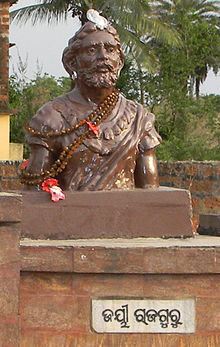
Jayee Rajguru was an Indian freedom fighter, who is the first State Marty of Odisha. His original name was Jaykrushna Rajguru Mahapatra. He was born on October 29, 1739 near Puri in Orissa to father Shri Chandra Rajguru and mother Smt. Haramani Debi. He came to be known as Jayee Rajguru after his appointment as `Rajguru` to the king. He grew up to be an outstanding Sanskrit scholar and intellectual of the 18th century. Later he fought for his motherland against the British. Rajguru not only proved to be a great royal priest but also an accomplished Commander-in-Chief and a freedom fighter. He was the first martyr in the national freedom struggle from Orissa.
Early Life of Jayee Rajguru
Jayee Rajguru belonged to a very scholarly family and his forefathers served the king of Khurda as his legal advisors and spiritual teachers. They were thus bestowed with the title “Rajguru”. Rajguru at a very early age became well versed with the Vedas, Indian Puranas and other scriptures. He is credited with writing thousands of shlokas and very soon became a renowned scholarly person among many pundits.
Jayee Rajguru was given the position of a scholar in the royal court of the king after the death of his father Chand Rajguru. At this time Orissa was facing severe drought problems. Many small kingdoms fought among themselves. During such confused state the king Dibyasingha Deb-II leaving behind his young son, Mukund Deb-II as the heir. However, as the king`s son was very young to rule Jayee Rajguru shouldered the responsibility of carrying the fairs of the state and managing the throne in 1798. He carried out well all the administrative duties and also brought about many significant changes.Later Life of Jayee Rajguru
During his rule the British were ruling the country. They had issued a notice stating that the rulers of all the smaller kingdoms had to accept their subjugation. Taxes were also levied on them. However, Jayee Rajguru rejected the notice. He requested all the residents not to bow down before the British but to fight for the honour of their motherland. He was also successful in gathering the support of the people of the neighbouring kingdoms. He gathered all the people together and carefully planned a defence strategy against the British. His zeal and vigour drew the attention of many people and many people began coming forward for help.
With time it almost became a mass movement with every household contributing a solider called Paika. These were well trained in different war skills.
Under the leadership of Jayee Rajguru the group of men were properly trained. Rajguru not only proved to be a great scholar and visionary but also an immensely talented soldier. He was a wise strategist who was well versed with all the knowledge of weaponry. His warfare skills were outstanding and he was probably the first to have employed the guerrilla warfare technique against the British. He was well aware about the superior quality of weaponry of the British and drawbacks of the conventional weapons of his army men.
Thus he supported the development of firearms in villages. On 1804 he along with his troops attacked the British force on the banks of Mahanadi River. They all fought very bravely that resulted in a serious set back for the British. The British soldiers thus arranged many other soldiers from Chennai to reinforce its troop. On December 1804 the final `Battle of Barunei` took place on the foothills of Barunei. In the battle the Paikas with their war skills and valour defeated the 7000 strong British army. The British officials finally resorted to Divide and Rule policy. They offered a few of the locals, large tax free land holding. In return they asked for information on Jayee Rajguru and also about his battle plan.
Jayee Rajguru was thus captured and arrested. He moved the King to a safe hideout and himself surrendered to the British. After his arrest the British officials took Rajguru to Medinipur. After a prolonged period of trial session he was given capital punishment for going against the state and the British officials. Jayee Rajguru fearlessly accepted the punishment as he thought that fighting for one`s freedom and for the honour of the motherland was not a crime. He was killed in a very brutal manner On December 6, 1806. His legs were tied to two different branches of a banyan tree and the branches were let off splitting his body in to two parts. This led to the end of the patriotism and courage of Jayee Rajguru.
|